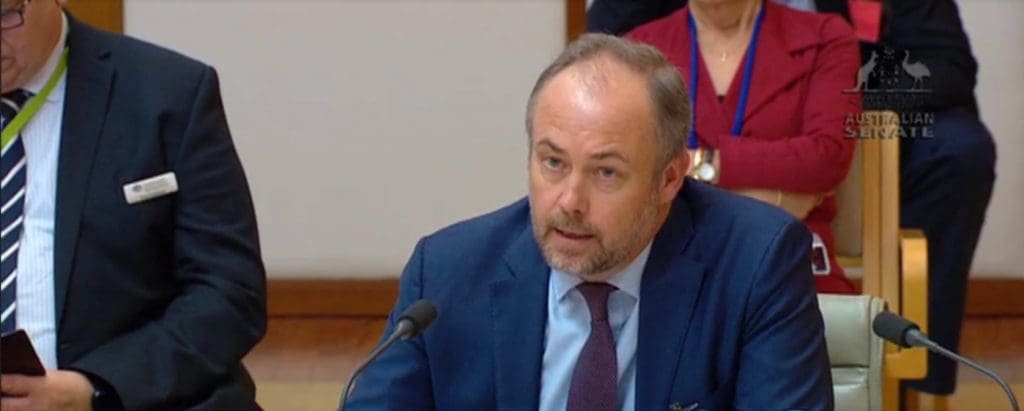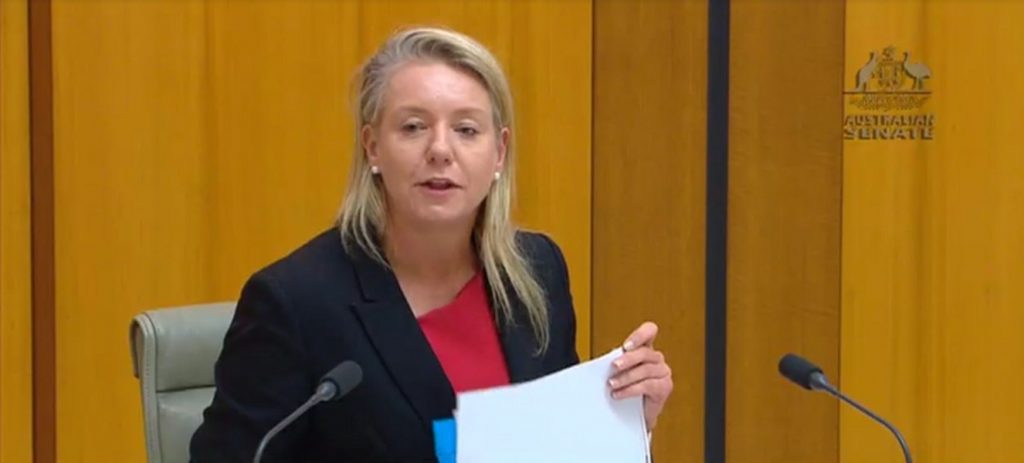
AWI chief operations officer John Roberts at yesterday’s Senate Estimates hearing.
AUSTRALIAN Wool Innovation has spent $6.3 million in growers’ levy funds on the WoolQ Market platform over the past five years but it has failed to generate any revenue, Senate Estimates was told yesterday.
Rural and Regional Affairs and Transport Legislation Committee member, Nationals Senator Bridget McKenzie sought elaboration from Australian Wool Innovation on questions on notice about the online trading platform.
AWI chief operations officer John Roberts told the RRAT committee that the $6.3 million expenditure figure also included the costs of reviews prior to the building of the platform.
Referring to a question on notice, Ms McKenzie said AWI’s 2019-20 annual operating plan had an operating target of 2 percent of all Australian wool to be traded by the WoolQ marketing tool.
“Please explain why only 939 bales were traded on WoolQ market auctions in the financial year which is less than one percent of total bales sold, particularly given 32,437 bales were created on the platform?” she asked.
Mr Roberts said WoolQ was formed out of the Wool Exchange Portal Working Group, which had representation from wool brokers who sold in excess of 50 percent of the Australian wool clip.
“There was also a strong representation of exporters, growers, testing authorities, the Australian Wool Exchange.
“Following that review and that feasibility study it was unanimous for the development and the go ahead of WoolQ.”
However, Ms McKenzie cut Mr Roberts off and appreciated WoolQ’s history.
“My question remains, why were 900-odd bales sold on it out of 32,000?”
Mr Roberts said “that degree of optimism” around WoolQ was how AWI got to the 2pc target.
“So you based the 2pc, to quote you, on a degree of optimism, what sort of data was under it, other than your optimism? the senator asked.
Mr Roberts said a significant number of brokers were represented within the working group, “and we made some assessments about how we would get to that (target).”
“So when you say made some assessments, was it Jack, Bill and Pete, reckoned we could get about 2pc, or did we have some data?”
“We would have some data, would have to go back, I would have to take that question on notice,” he said.
No WoolQ revenue, so no return on investment

Senator Bridget McKenzie grills AWI at Senate Estimates yesterday.
When asked what WoolQ’s return on investment was, Mr Robert said AWI had not derived a revenue stream from the platform.
“Because we are yet to start charging for the WoolQ Market service here because we haven’t had the volumes.”
Mr Roberts rejected Senator McKenzie’s suggestion that people did not see WoolQ as valuable.
“Our experience has been that people do see it as valuable and we’ve had very positive feedback with the brokers and the exporters and the growers we’ve worked with.
“The challenge is getting people to look at it, not just in terms of the value proposition that’s delivered by the selling proposition,” he said.
“But if you look at the entire platform and what it can deliver, in terms of the suite of tools, including the ready reckoner price assessment tool, the industry network and also as we start to get overseas brands and consumers attracted to that site we believe that once the volume comes…
“We’re need to sell the entire value proposition which has been difficult, particularly last year when we weren’t able to face-to-face meetings, which is where we get the real traction.”
Mr Roberts said he was referring to getting traction among Australian growers and “getting the bales”.
“The issue we have is we don’t have enough volume.
“We’ve had 13 wool auctions, online auctions, to this point, but the volumes have been limited.”
No deadline on ‘pulling up stumps’ on WoolQ
When asked at what point would AWI “pull up stumps” on WoolQ after the expenditure of $6.3 million, Mr Roberts said now that WoolQ is free to work with growers more closely to get more volume, it could work toward a target of 2pc of traded wool volume by July 2022.
“I still think we can work towards that.”
Senator McKenzie said WoolQ’s target of doubling within a year its current annual bale volume of just under 1pc of traded wool was very ambitious “and your track record would suggest that it ain’t going to happen.”
“It is a challenge and it is optimistic, but I think we are now in a situation where we can get out and get volume on that platform.”
Mr Robert said WoolQ only started trialling its selling platform in April last year.
“So the selling mechanism has really only been on a pilot stage until now, so we now have the functionality well and truly working well and the feedback we’ve had from the exporters who have been using it has been positive.”
When Senator McKenzie said the optimism around WoolQ had proved to be unfounded and she queried whether the platform was wanted, based on the trouble WoolQ was having in getting Australians to use it.
Mr Roberts said WoolQ presented an opportunity for the Australian industry “to showcase themselves and tell the story that the narrative has changed.”
“In the sense that we’ve always had a good story to tell … we tried to push that up the supply chain to the overseas brands and the consumers
“Previously we’ve been in a world which has been dominated by synthetic fibres and price points, we’re now in a situation where the world is interested in the wool grower’s story,” he said.
“WoolQ provides an opportunity for growers to profile themselves and for brands and consumers to see their stories.”
Mr Roberts said WoolQ was selling bales of wool and telling stories.
“But it has been unable to have been done thus far.
“I just think it incredible that you can throw so much money at something that isn’t actually delivering for you, but I will be asking for updates at every single estimates and I hope that in 12 months’ time you are sitting here telling me that you were right and I was wrong,” she said.
“But I wouldn’t put a bottle of wine on it.”

Everyone I communicate with, from Minister Littleproud down, agrees there is a major problem with the culture in Australian Wool Innovations. The sixty four dollar question is: How does the levy payer fix it? Remember the government is the biggest levy payer and senators are asking some serious questions. We don’t want to lose the government. They like us and have to address the wastage.
How do sporting organisations fix their culture? They sack the CEO and go from there. Is it time to find a new CEO for AWI?
Jim, changing the chief executive officer won’t change the culture of Australian Wool Innovation. The culture is embedded in the psyche of our statutory wool organisations since the very beginning. The root of the rot is the statutory taxes. Statutory taxes or levies, as they are usually called, are the organisation’s primary source of income, so naturally the primary focus becomes conning the poor old wool grower to keep on paying the tax.
In the meantime, research is neglected and our industry has no leadership on many issues, and perhaps the most critical being national standards for animal ethics and mulesing. At least back in the 1960s, national and international standards were established for wool testing. Today with mulesing and animal ethics — the issues of our time — in hiatus, the vacuum is filled with with a multitude of accreditation schemes that are costly to the industry, inefficient and confusing to the customer.
Peter, I agree, and it is why I made the comment sometime ago that AWI needs to be dragged out into the deepest part of the ocean and sunk. Sadly, the culture is set in concrete. So the sixty four dollar question is: How do we fix the situation?
The only way I can see is to reduce the levy down to 1 percent this time around. The wastage is incredible. I think of the $60 million spent of flies and we have had the worst fly year for twenty years. The wastage just will not stop.
What is the cost to existing supply chains of the competition and duplication of WoolQ?
Why has AWI persisted in ‘going alone’ in this field instead of working with commercial versions of a similar concept?
At several times during the past two years WoolQ could have made a difference, but it failed eg trade wars, COVID.
AWI, which has inherited the culture of its predecessors, has a belief that the commercial industry only frustrates progress. AWI believes if it was all left to AWI the industry would be bountiful – the ingrained belief of both statutory organisations and agrarian socialists.
Mr. Roberts, please tell us who are the growers, exporters and brokers who support, as you attest, the wool portal? It was a dead duck from the day your committee delivered the results of the Wool Selling System Review and you knew it then. But still you have overseen the waste of another $6 million of growers’ funds.
Well done Senator McKenzie, you are far more value to our industry than all the other politicians put together.